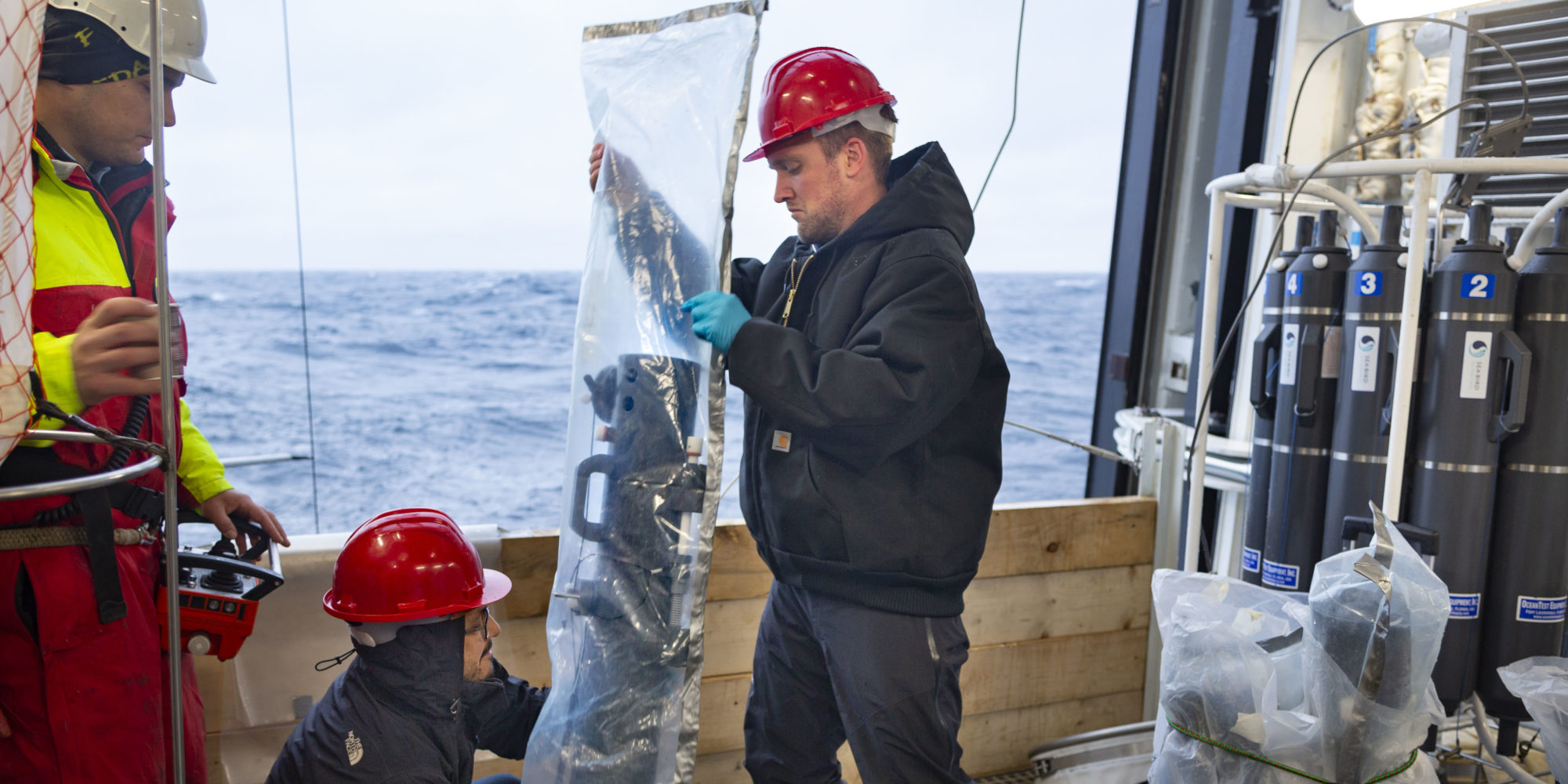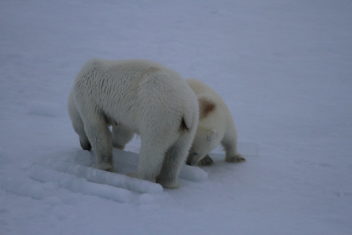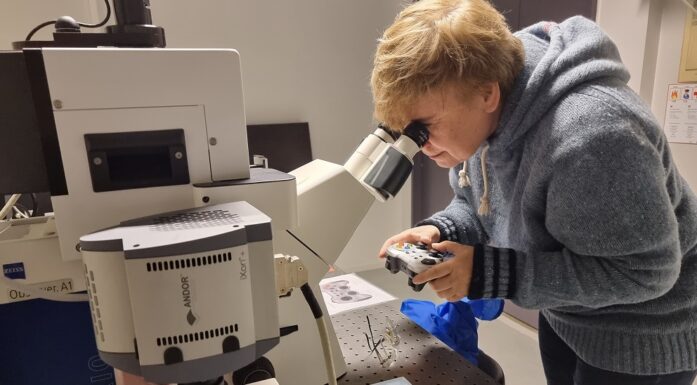What happens in the Barents Sea if the ice disappears?
The Arctic’s once impenetrable ice cap is melting away, with profound consequences for everything from ocean circulation patterns to fish numbers and diversity. The Nansen Legacy Project, including NTNU biologists, chemists and engineers, is working to better understand what these changes mean for the Barents Sea and the Arctic Basin
The microscopic marine world is full of predators, a world where who eats what can make a difference to how an entire ecosystem is structured. That’s especially important in the Arctic, where the melting ice cover can affect the microorganisms that shelter in and around the ice.
NTNU biologists Nicole Aberle-Malzahn and Angela Stippkugel are among the researchers who are now working on a long-term project trapping tiny arctic organisms and trying to figure out what they eat and what eats them.
Aboard the RV Kronprins Haakon, Norway’s brand-new icebreaker, they’ve voyaged into the increasingly ice-free north to catch their prey as part of the Nansen Legacy Project, a six-year, multi-disciplinary, multi-organizational effort led by the UiT—The Arctic University of Norway, and nine other research institutes including NTNU.
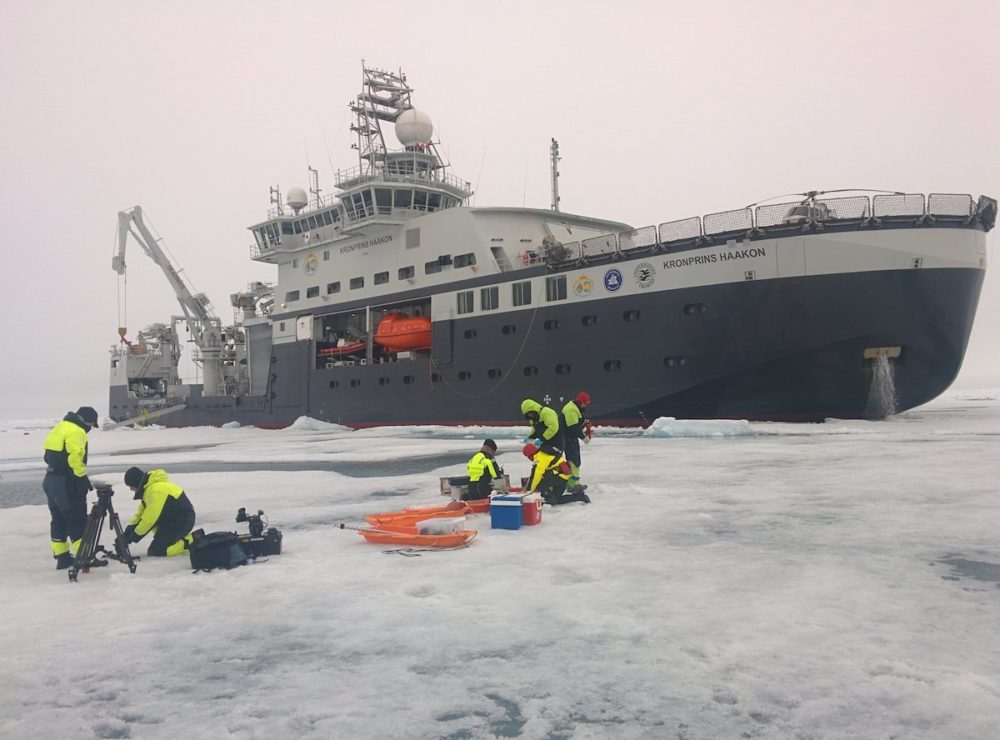
The new Norwegian icebreaker RV Kronprins Haakon, during one of the Nansen Legacy cruises. Photo: Pal Gunnar Ellingsen/Nansen Legacy Project
In addition to biological surveys, the project is also studying currents, waves and the atmosphere, as well as conducting chemical surveys of Barents Sea water. Another aspect of the project involves refining the use of autonomous underwater vehicles in the Barents Sea environment. NTNU researchers are involved in these last two efforts.
The Nansen Legacy Project
The Nansen Legacy is a collaborative project between ten Norwegian research institutions with Arctic marine expertise, and with competence and perspectives including education, management and contact with different user groups.
Project period: 2018-2023
Budget: 740 million NOK
Funding: 50% in-kind from involved institutions, 25% from the Research Council of Norway, 25% from the Norwegian Ministry of Education and Research
Research group: More than 130 scientists from the partner institutions, about 50 recruitment positions (PhD and postdocs), associated members, international collaborators
Website: https://www.nansenlegacy.org
“The whole project is dealing with ecosystem changes and temperature changes and what influences the temperatures have on the Barents Sea overall,” said Aberle-Malzahn, an associate professor in NTNU’s Department of Biology. “The biology part is to analyse all the different components in the ecosystem, from phytoplankton to polar cod, because they rely on the sea ice habitat and have adapted their life cycles accordingly. The question is how the whole ecosystem will change when the ice is gone for much of the year.”
- You might also like: When a hole in the ice is a big problem
Gateway to the Arctic
The Nansen Legacy Project chose to focus on the Barents Sea as the gateway to the Arctic Ocean because climate change has made it and the Arctic Ocean more and more accessible, Marit Reigstad, the project’s coordinator, wrote with her colleagues in an article earlier this year.
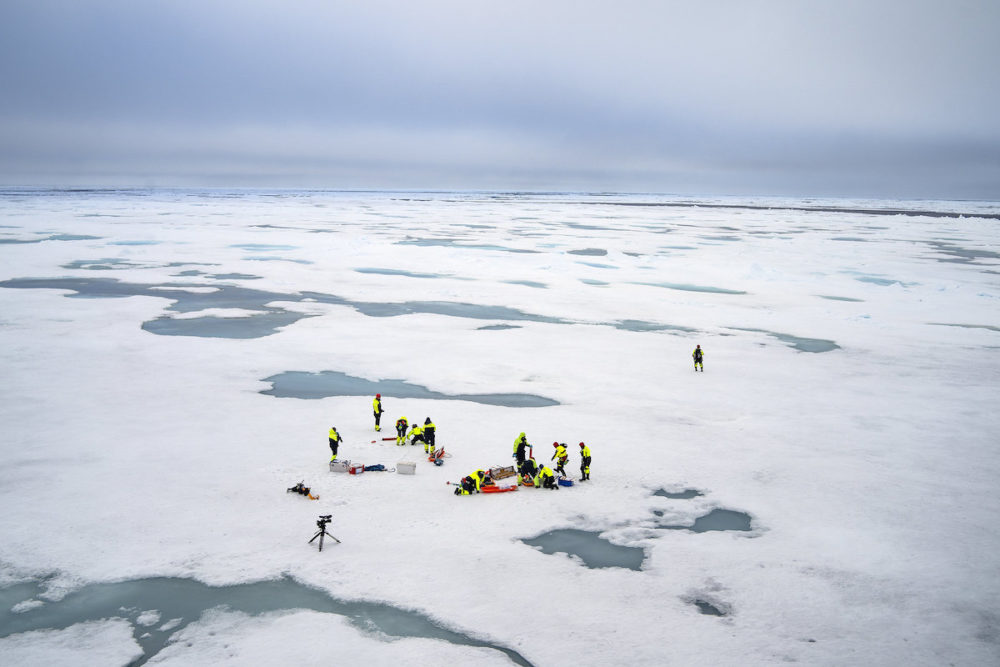
Researchers from the Nansen Legacy Project out on the ice. Photo: Siv N. K. Hoff_6/Nansen Legacy Project
“The increasing area of open waters in the northern Barents Sea literally opens the Arctic to newcomers,” Reigstad wrote. “These include sub-Arctic fish species like cod and haddock, invasive species like the snow crab, and the fisheries that they attract.”
Another advantage of focusing research on the northern Barents Sea is that Norway undertook a similar study in the southern Barents Sea from 1984-1989, which allows researchers to see how the ecosystem has changed since that time.
In the end, by collecting a range of information about everything from sea ice and the atmosphere to the chemistry and biology of the Barents Sea, the team hopes to document what is there now, and predict what will happen as the Earth warms. The goal is to provide a sound scientific basis for future management— one that incorporates the unpredictability of climate change.
- You might also like: Ocean life in 3D — mapping phytoplankton with a smart AUV
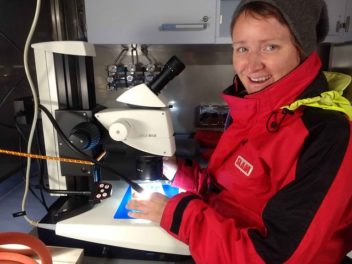
PhD Angela Stippkugel sorts zooplankton for experiments on RV Kronprins Haakon. Photo: Bodil Bluhm, Nansen Legacy
The puzzle that is plankton
Plankton are the mostly microscopic plants and animals that form the base of the food web. Phytoplankton are what biologists call “primary producers,” because they, like terrestrial plants, can thrive by relying on sunlight and carbon dioxide.
Zooplankton eat phytoplankton and then other creatures (such as fish larvae, jellyfish and small pelagic fish) eat zooplankton. This relationship is called a food web, because the interactions between the eaters and who is being eaten are complicated and interrelated. If one thing changes — say the availability of one kind of plankton — it can affect everything else.
Beyond that, the amounts and types of plankton vary tremendously — as can the number and types of creatures that feed on the plankton. All of this can also change, based on water temperatures, ice cover, light availability and nutrients in the seawater.
That means that changing ice cover will result in changes in the amount and availability of light which, along with changing ocean temperatures and nutrients in the Barents Sea will alter the already complicated relationships between these microscopic marine creatures and the critters that eat them. That’s exactly what Aberle-Malzahn and Stippkugel hope to better understand.
- You might also like: A day in the life of a jellyfish hunter
Flasks of predators in a cold room
The two researchers are studying this problem by collecting plankton and conducting feeding experiments with the voracious creatures to see who eats what and how much at different water temperatures.
During their time on the RV Kronprins Haakon in August 2019 and 2020 they collected water samples at different locations and depths in the ocean. They then filtered this water to remove the organic matter and larger zooplankton, which would force the remaining, smaller zooplankton to eat whatever was left. Biologists collectively call the smaller zooplankton “micrograzers.”
They then put different percentages of their captives in flasks and stored the flasks at different temperatures in a cold room aboard the ship. The water temperatures are key, because if the Barents Sea warms over time, then the plankton will have higher energy needs and will need to eat more, the researchers said. Another issue is what the zooplankton in the flasks decide to eat.
“Grazing patterns are highly temperature dependent,” Aberle-Malzahn said. “We want to know how their feeding rates and selectivity patterns change in relation to the temperature.”
- You might also like: Shedding light on zooplankton in the dark
Icebreaker allows wintertime measurements
Stippkugel, who is conducting the research as part of her PhD project, will take part in all seasonal cruises in 2019/2020 and conduct the feeding studies in close collaboration with a PhD candidate from Tromsø and a postdoc from the University Centre in Svalbard (UNIS). Some of these samples will be taken during fall and winter, when there is almost nothing known about the community composition of micrograzers and their feeding behaviour.
The RV Kronprins Haakon is an icebreaker, “which allows us to access the Northern Barents Sea and the Arctic to make measurements in the wintertime,” Aberle-Malzahn said. “Marine life during the polar night season has not been investigated that much to date, because previously it wasn’t that easy to do research during the winter months in the ice. Now we can look at grazing interactions even in the winter.”
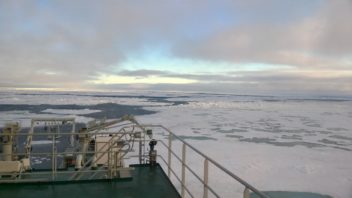
View off the back on the RV Kronprins Haakon, Norway’s new icebreaker, during one of the Nansen Legacy cruises. Photo: Nicole Aberle-Malzahn, NTNU
The researchers can also estimate the nutritional quality of the plankton that are being eaten by measuring their fatty acid composition and elemental carbon, nitrogen and phosphorus concentrations.
“If the food that is available is of high quality, it promotes the growth and reproduction of larger zooplankton and thus sustains the top predators in the oceans, such as fish and whales,” Aberle-Malzahn said.
Iron, manganese vital to marine ecosystem
How can you determine the concentration of certain metals (also called trace elements) that are found in infinitesimal amounts in the ocean when you’re taking samples from a boat made of metal?
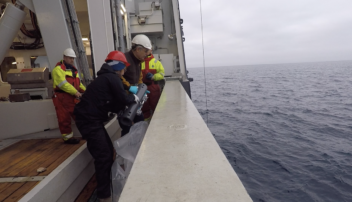
Nicolas Sanchez, left, and Murat Ardelan, right, retrieve the special water sampler, called a Go-Flo, that they use to collect ocean water for trace metal analysis. Photo: Nicole Aberle-Malzahn
That’s the challenge that faces Murat V. Ardelan, a professor of chemistry at NTNU, and a group of marine biogeochemists who are involved in the Nansen Legacy project.
Nicolas Sanchez, a postdoc in NTNU’s Chemistry Department, is measuring a range of trace metals in the ocean water, such as iron, manganese, cadmium and zinc, among others. Trace metals are micronutrients that nearly all living organisms, including plants and animals need to thrive.
“In the case of the marine environment, we are interested on how the availability of these micronutrients affects the microalgae and vice versa,” Sanchez said.
Iron offers a good example of the critical role that micronutrients can play, Ardelan said.
“Iron is crucial to many vital reactions, like photosynthesis” he said. “Without iron and manganese, photosynthesis would collapse.”
That’s especially crucial in the oceans because these two metals have very low solubility in the seawater, and phytoplankton rely on them for photosynthesis. The bioavailable forms of iron in the seawater, along with other nutrients, such as nitrate, also called NO3, may have a controlling impact on the primary productivity in the Arctic marine ecosystem.
“We are going to test this hypothesis”, Ardelan said.
Mercury and lead an important focus
Ardelan says that there is relatively little information about how these trace elements have changed over time, which is why collecting data during the Nansen Legacy Project is so important.
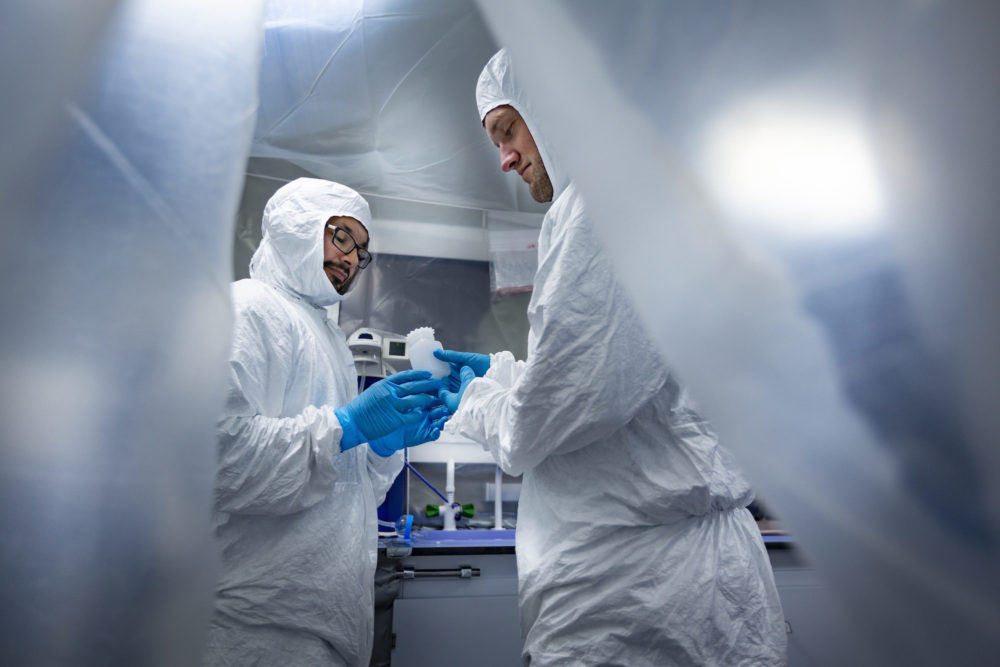
Postdoc Nicolas Sanchez and PhD candidate Stephen Kohler are dressed in full bunny suits to limit the possibility of contaminating their water samples. Photo:courtesy © Christian Morel/www.christianmorel.net/The Nansen Legacy
“In general, our knowledge on trace elements in this region is still very weak,” he said.
Ardelan and PhD candidate Stephen Kohler are also looking at trace elements that aren’t necessarily good for organisms, such as lead and mercury. Mercury in particular can be released when frozen soils, called permafrost melt due to global warming.
“If permafrost thaws, like we know it is, we know we will have a lot of mercury in the Arctic,” he said. “Even if only 10 per cent of this mercury reaches the ocean, it will double the amount of mercury in the seawater.”
“We may know a good deal about how mercury accumulates in higher trophic levels, such as in fish, seals and polar bears,” Sanchez said. “But with increasing inputs of this element into the marine environment, we need to know more about how the most toxic form, methylmercury is generated and is cycled at the base of the marine food web.”
An ultra-clean room
The trick with studying micronutrients and trace metals in seawater is that the amounts the researchers measure are very tiny.
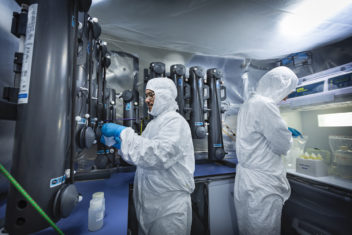
Nicholas Sanchez (left) and Stephen Kohler take samples that they will test for trace metals while inside a special bubble within a room, designed to prevent contamination. Photo: courtesy©Christian Morel/www.christianmorel.net/The Nansen Legacy
Iron and other bio-essential trace elements have extremely low solubility in seawater, which is why their concentrations are extremely low in the sea, expressed as parts per billion (ppb).
For comparison, five drops of ink in about 200 L of water is the equivalent of 1 part per million (ppm). One ppb is 1000 times less than that.
Any potential sources of contamination have to be eliminated when the researchers take their samples. That means no metal samplers, and that the equipment that is used to sample ocean water has to be pushed far away from the (metal) boat, Ardelan said.
“We have to use polymer Kevlar wire, for example,” he said. “And our sampler is made of Teflon.”
The researchers also worked in an ultra-clean room, where a part of the lab was encased in what was effectively a room-sized plastic bubble.
The researchers dressed from head to toe in special overgarments called “clean suits” and had to be very careful with every step not to accidently introduce contamination to the samples they had collected. All materials used in the lab had to be prevented from coming in contact with metal components, and also had to be thoroughly washed with acid and ultrapure water.
Other NTNU/ Nansen Legacy efforts
Martin Ludvigsen, an NTNU professor and manager of the university's Applied Underwater Robotics Lab (AUR-Lab) is part of the Nansen Legacy team as co-leader of one of the project's research focuses on Technology and Method Development. The focus is on developing enabling technology for mapping and monitoring of extreme environments, such as under the ice.
Petter Nordgren, a postdoc at the AUR-Lab, is developing and testing a robust navigation system specially designed for under-ice AUV operations, including an embedded support for navigation under drift ice.
Trygve Olav Fossum, a PhD candidate at the AUR-Lab, has also worked with the Nansen Legacy project to track eddies and Arctic front between cold Arctic and warm Atlantic water masses near the polar ice edge.
Geir Johnsen, an NTNU professor and marine biologist who works with underwater vehicles, is also on the Nansen Legacy team as co-leader of the Legacy and Impact research focus group.
“Some of these materials may even be washed months ahead of an oceanographic cruise,” Sanchez said.
Carbon’s role in seawater
Ardelan’s group, particularly PhD candidate Maria Guadalupe Digernes, is also studying organic carbon characterization to understand its role in regulating and controlling atmospheric CO2 and how it binds up metals, which determines the bioavailability and toxicity of the metals.
Organic matter (both particulate and dissolved forms) is like a “bank account” for carbon, Ardelan says. If the carbon stays longer in the marine system in organic form, that means it’s stored “in the bank”, and could mean there is be less CO2 in the atmosphere.
Atlantification of the Arctic
Another value of the micronutrient data is that it can help researchers understand how climate change is changing the very nature of the different parts of the ocean. One trend that has already been recorded by oceanographers is the tendency of Atlantic Ocean water, which is warm and salty, to push farther north into the Arctic, which is colder and less salty, in a process called the Atlantification of the Arctic.
“Atlantic waters have completely different chemistry than Arctic water,” Ardelan said.
Studying the bio-essential trace metals (micronutrients), toxic metals and dissolved organic carbon in the Barents Sea should allow researchers to build a much stronger understanding of how these big picture processes are changing over time. They should also be able to use the information to make predictions about the future, Ardelan said.
“If you don’t know what’s going on with dissolved organic carbon, micronutrients and toxic substances, you don’t have the whole picture,” he said.
Here’s a video that shows what it’s like aboard the Kronprins Haakon during one of the Nansen Legacy cruises:
